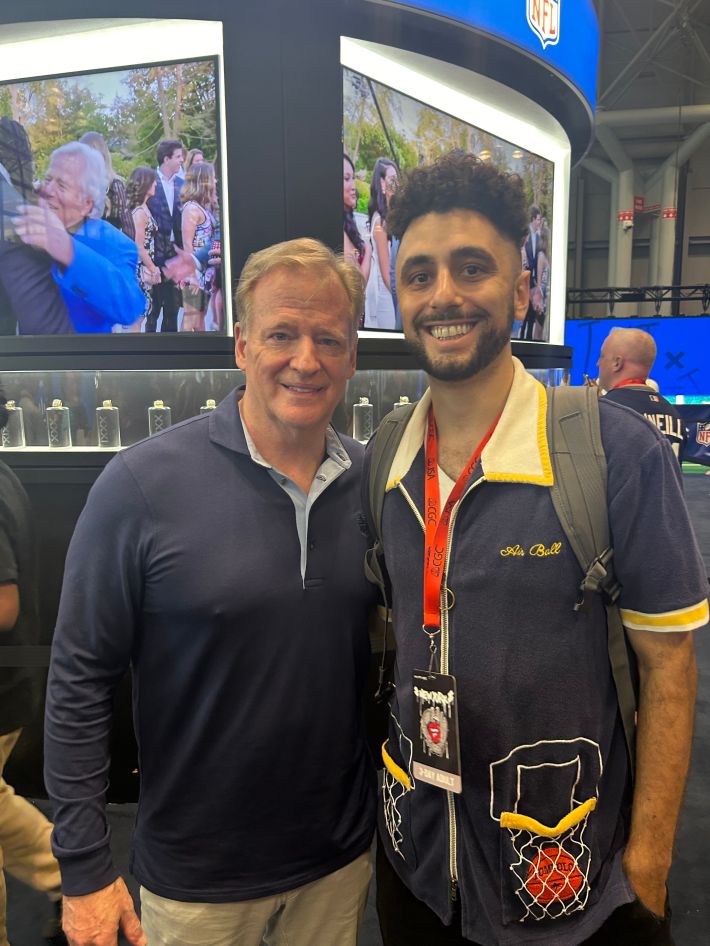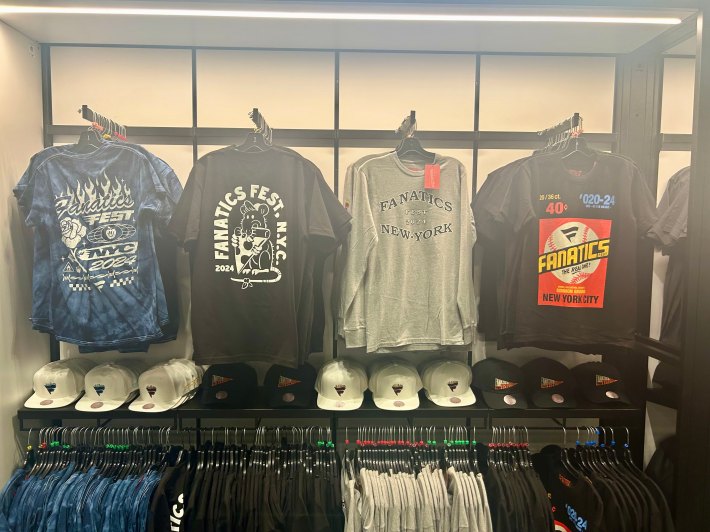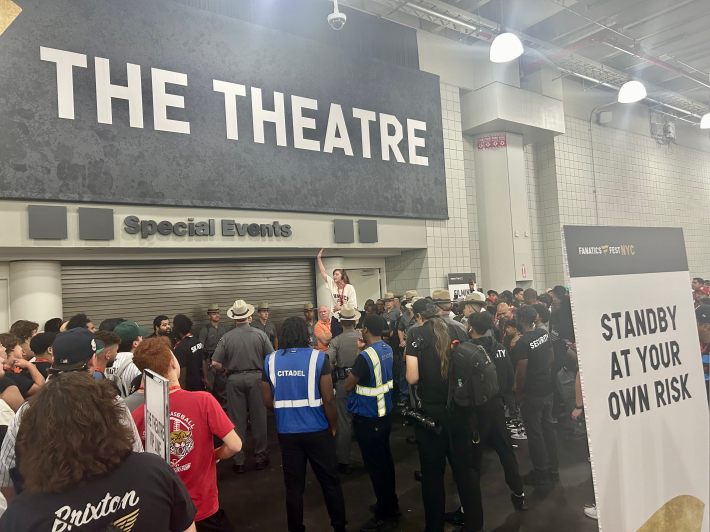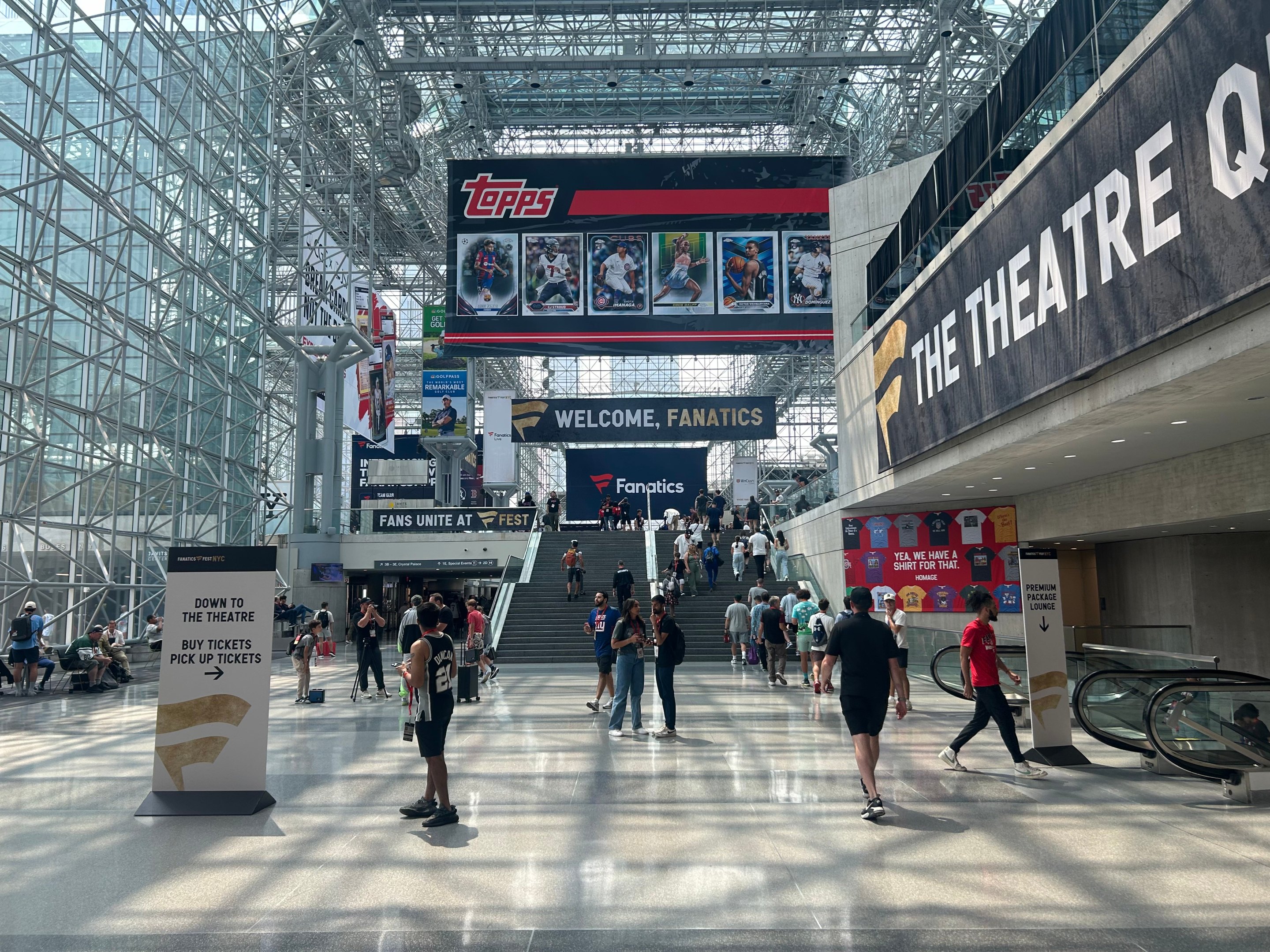NEW YORK CITY — Throughout the three days I spent at Fanatics Fest, a phrase kept rattling around in my head: “Just be in sports culture heavy.”
This past weekend was the inaugural edition of an event that Fanatics CEO Michael Rubin hopes to establish as the sports version of Comic Con. Just like New York Comic Con, Fanatics Fest was held at the Javits Center in Manhattan, offering high-profile panels, as well as lots of merch and trading cards for sale, and opportunities to pay for autographs and photo-ops. Tom Brady was there. Peyton and Eli Manning were there. Hulk Hogan was there, profiting from the longest line of autograph seekers I saw all weekend.
I went out of curiosity about what kind of event Rubin, the head of an inescapable sports merchandise company infamous for inflicting its shoddy products on fans and athletes alike, was capable of organizing. What would his vision of an event where sports, culture, and collecting collide actually look like?
I went into Fanatics Fest with an open mind, leaning on the wisdom of Gary Vaynerchuk, a.k.a. Gary Vee, the kind of fast-talking, self-proclaimed entrepreneur who tends to gravitate toward Rubin’s empire. His promotional video for Fanatics Fest included his plan to wander around and “just be in sports culture heavy.” I tried to adopt the same mindset.
Friday, Aug. 16
A three-day Fanatics Fest pass cost about $150. It got me in the door and allowed me as standby for all the panels, but if I wanted an autograph or photo-op with my favorite athlete, that would cost extra, on a per-athlete basis.
I got my pass and headed straight to the first panel event, which was located in the Javits Center theater. Everything else—trading cards and collectibles, autographs, and various sports league installations and games for kids—was upstairs on the show floor.
The first panel, “Character Counts," featured Derek Jeter and David Ortiz, whom Fanatics promised would be sharing “their experiences learning from mentors and becoming philanthropic leaders, while having integrity shape their everyday actions.” Moderator Ryan Clark’s first question to Jeter was, “What was it like to wear the pinstripes?” The guy sitting next to me left halfway through because he wanted C.C. Sabathia’s autograph more than he wanted to listen to Jeter and Ortiz talk at length about how they’re friends now, even though they used to play for rival teams. That was his mistake, because he missed Clark asking a truly incredible question: “For you, Derek, to go through 9/11 and be not only just a leader but a beacon of hope in this city, what were some of those moments like for you? How proud were you to be not only an American but a New Yorker at that time?”
The panel ended after 45 minutes. I re-entered the theater for the next panel, “Courtside Conversations,” which was marketed as “where basketball meets culture.” The rapper Quavo was supposed to be there, but he was a no-show. I later spotted him upstairs. The other panelists were Paolo Banchero, Julius Erving, and Dom “The Shoe Surgeon” Ciambrone, whom Fanatics labeled a “pop culture icon.” (Nike recently sued Ciambrone, alleging counterfeiting and trademark infringement; Banchero is a Jordan Brand athlete.) ESPN analyst Jay Williams moderated and began with the bold assertion that “there were some really big cultural, iconic moments that happened this year in sports.” He then brought up the Kendrick Lamar-Drake beef and “Kyrie, Boston, everything around that.” Then Williams just kind of … asked Banchero to talk about either of those things.
I tried to get into the next panel, which featured Tom Brady and Stephen A. Smith, but they cut the line off with a hundred or so people still trying to enter the theater. All good. I used the opportunity to wander around upstairs and familiarize myself with the venue. Closer to the entrance of the show floor were dozens of sports league installations, which were pretty thoughtful and cool. The WWE setup allowed for fans to walk out onto a stage while their theme song blared. Kids could shoot hoops at a few different stations.
The 40-yard dash station was packed with teenage onlookers, which I realized was because Adin Ross was busy working the crowd. Ross is a full-time streamer who was permanently banned from Twitch in 2023 for being too much of an asshole, and now uses the streaming platform Kick to do things like gift a custom Cybertruck to Donald Trump. He was one of several high-profile streamers and influencers who attended Fanatics Fest, and judging by the sizes of the crowds they attracted, as many people paid to see them as they did the professional athletes. Ross and another famous streamer named Darren Watkins Jr., better known as IShowSpeed, later raced each other in a 40-yard dash and briefly wrestled in front of Dana White. Hundreds of screaming fans pressed close to watch while various all-stars and Hall of Famers were elsewhere in the building.
I headed toward a portion of the NFL installation that featured a bunch of Super Bowl rings and almost ran into NFL Commissioner Roger Goodell. No more than 30 feet away from a throng of Ross fans, Goodell was taking free pictures with maybe a dozen people. I stopped to get one with him. Who could pass up an opportunity to get a photo with the guy who suspended Stephen Ross for 11 weeks?

The back of the show floor featured the zone for autographs and photo-ops. The photo-op section was basically just a line of people who’d already paid in advance, waiting for their opportunity to get 15 seconds with their favorite athlete. The athletes themselves were hidden behind a maze of black curtains; no free peeking for plebian passersby. The autograph section had its own confusing queue system. If you squinted, you could kind of see the athletes signing stuff. Kareem Abdul-Jabbar’s line was not nearly as long as I expected, until I saw that he charged $599 for an autograph, which as far as I could tell was the most of any athlete all weekend.
Fanatics Fest stuck the most star-studded panel of the day—Jalen Brunson, Josh Hart, Tom Brady, and Lil Wayne—on what they called the “center stage” of the main floor. There were significantly fewer seats and space compared to the theater. As the panel got underway, Rubin kept popping his head out from behind the stage curtains, as if to say, “I’m here, too!”
Lil Wayne proudly told the crowd he had not eaten fast food in 25 years. Meanwhile, Brady talked like he was the Football Pope: “The important part for everyone here is that when you go through life, and you find something that you love to do, you gotta always be curious about how to find the next way to make improvements to what you’re doing, whether you own a business, whether you’re a kid in school, an athlete, an entertainer, you always have to dig deeper within yourself to wake up every day thinking about what you have to do to improve–and the easiest way for you to do that is to love what you do.”
Brady did not inspire the crowd, and someone backstage must have picked up on the diminishing energy. Suddenly IShowSpeed popped on stage, which seemed to come as a surprise to the rest of the panel. He sat right between Brady and Lil Wayne, and asked them about the times they’ve interacted with Cristiano Ronaldo, his favorite soccer player. It was an inside joke for the kids. IShowSpeed also did a backflip off a chair.
The next few hours were spent wandering, including a pilgrimage to the official Fanatics Fest store, which was selling a variety of convention-themed gear: T-shirts for $35 to $45, jackets for $150, and jerseys for $75. Everything seemed to be spelled correctly, which made me wonder if a company other than Fanatics had printed the clothes.

At the end of the day, I approached a group of men in their mid-to-late 20s and asked them to rate their experiences. One of them, Amar, lives in New York; his college buddies had come to visit from other nearby East Coast cities. “I think the fact that they put all of this together and had such big names here is amazing,” Amar said. He thought it was a well-put-together event. His friend Mike agreed, though he complained about the “wildly expensive” autograph prices and said the photo-ops felt like a “conveyor belt.”
Saturday, Aug. 17
I arrived at Javits Center bright and early for the first panel of the day, called “Athletes to Icons: Women Transforming Sports and Media.” It promised “valuable insights into navigating the intersection of athletics, entrepreneurship, and digital presence.” Broadcaster Taylor Rooks had to carry the Q&A portion alongside her co-host, Alix Earle, a TikToker and podcaster who’s currently dealing with a bit of backlash over some racist posts she allegedly made when she was 13 (she’s now 23). The rest of the panel included Livvy Dunne, La La Anthony, Paige Spiranac, Shelley Zalis, and Allison Kuch. Spiranac, a former college golfer now better known as an influencer with 4 million followers, told the crowd she has a 97 percent male audience and enjoys bonding with men about issues around body shaming.
Another panel, vaguely referred to as the Ultimate Fantasy Draft, was hosted by Matthew Berry. “Each special guest will offer their professional takes on what it takes to be great and fantasy expertise like never seen before,” the promo read. This turned out to be an abridged fantasy football draft—each panelist made three selections as an increasingly stressed-out Berry tried to get it all done within 45 minutes.
Internet-famous comedian Druski got by far the loudest applause from the sparse crowd—more than Fred Taylor (who had the first pick), Jerry Rice (fourth pick), and Kyle Kuzma (fifth pick). Again, the influencer carried the day. Kuzma picked Lamar Jackson fifth. Druski picked Ezekiel Elliott ninth, then Patrick Mahomes with his second-round pick. He made it very clear that he does not follow football, and was treating this panel with the amount of care and attention it deserved.
The first of two big panels that day featured Kevin Durant and Anthony Edwards in conversation, moderated by Jalen Rose. The line to get into the theater was absolutely ridiculous. I waited patiently, but knew I was fucked. When the inevitable happened—security staff announced the theater was filled to capacity—hundreds of cranky people on standby started knocking over the dividers that had penned them in. “We paid all this money and the only good thing is the chicken wings,” one guy said as he stormed off.
I spent a little time in the collectibles and trading cards section of the show floor. Countless vendors were buying, selling, and trading to a steady stream of collectors. In the autograph section, Lawrence Taylor had a robust turnout. So did Hulk Hogan, whose line stretched all the way from the very back of the show floor to the NFL installation section. Rubin was floating around the show floor on Saturday. He’d take a few selfies, then his entourage would move him somewhere else.
Rubin inserted himself onto a panel with Travis Scott, moderated by Michael Strahan, for the late afternoon. Rubin has always been deliberate about placing himself in and around the world of hip-hop—he refers to Meek Mill as one of his closest friends—but his overfamiliarity may finally be starting to rub people the wrong way. On Aug. 14, a few days before the start of Fanatics Fest, Rubin went on The Breakfast Club and said that one thing he doesn’t like about “black culture” is “black hate on hate,” in reference to what he deems to be a propensity for black people to “tear each other down.” Rubin swiftly apologized after he was called out publicly by rapper Schoolboy Q. None of this came up during Rubin’s talk with Scott.
Scott was by far the biggest draw among the panelists, and once again, my chances of entering the theater seemed slim. In the least surprising development of all time, Scott’s young fans rushed past the line when the doors to the theater opened. Pandemonium ensued. Parents with little kids were pissed and scared. Dozens of cops and security guards swarmed the area. “Michael Rubin needs to address the crowd,” a guy behind me said. Another person started shouting, “Is this what Astroworld was like?” over and over again. A security staffer somehow managed to calm the remaining crowd, and established a system to get everyone else into the theater. There would be no capacity limits for Michael Rubin and Travis Scott.

Strahan opened with some questions for Rubin, which kind of felt like when a team wins the championship and you have to listen to the owner talk before the star player. Then Scott and Rubin complimented each other for 45 minutes, making sure everyone knew that they are real-life friends. Rubin said in 10 years he wants his kids to be able to say he built the “most beloved sports brand” and one of the most beloved brands in the world. He claimed that Scott took a real risk and showed “courage” by doing a collaboration with McDonald’s. And he doled out some billionaire advice: “The second you don’t stay humble, you’re getting a bullet in the back of the head. It’s the fucking truth. I’m always humble. I’m always paranoid. And you gotta sleep with one eye in this business, because people are coming for you all the time.”
At the end of the panel, Scott performed two songs which smoothed things over with the younger attendees.
Sunday, Aug. 18
The final day's big event was a press conference for Mike Tyson and Jake Paul, who are purportedly going to fight each other on Nov. 15. Another insanely long line developed, and a few hundred people who were on standby (myself included) couldn’t get in. More dividers went clanking to the ground, as cries of “bullshit!” could be heard far and wide.
Upstairs in the showroom, few athletes and celebrities roamed around. The trading card and collectible tables were already starting to clear out. I needed to find Gary Vee before the weekend ended. That proved to be an easy task. He was signing autographs at the booth for VeeFriends, some sort of NFT scheme he’s slapped his name on. I snapped a picture of him from afar; he looked at me right when I took it. As our eyes met, it almost felt like he was speaking to me telepathically: Just be in sports culture heavy. “Absolutely,” I thought. His shirt said “positive porcupine” on it.
I walked back toward the theater for the very last panel. On the way over, I stopped to interview a man named Shamar, and his teenage stepson Jayzire. They drove in from Connecticut and stayed for all three days. They agreed Friday was the best day of the event—they enjoyed seeing influencers and athletes in their element, on the show floor, among everyone else.
“Once we found out we had to pay for autographs, I was like No,” Shamar said with a laugh. “I said, ‘I’ll catch some guys walking around.’” Unfortunately, Jayzire did not get any autographs from his favorite wrestlers, because security was tighter for them. He lit up when I mentioned IShowSpeed, and said he got a photo of the streamer. “It was a good experience to have for the first Fanatics Fest,” Jayzire concluded. “But there are some things that could be improved.”
The final panel, “Champions of Change," had quite an impressive slate: New York Liberty star Sabrina Ionescu, NBA Commissioner Adam Silver, and Kareem Abdul-Jabbar. Taylor Rooks moderated. The promotional material for the panel promised "an inspiring main stage talk … Through their passionate dialogue, they champion early sports participation among youth, encouraging a new generation to embrace athleticism and pursue their dreams fearlessly.”
No passionate dialogue transpired. Silver hinted at a return of the Ionescu vs. Steph Curry three-point contest at this year’s All-Star weekend, which struck me as perhaps the most newsworthy tidbit to come out of Fanatics Fest. Rooks wrapped things up by saying, “I hope you all leave here today feeling empowered to use your voice, inspired, and looking for change.”
The train ride home left plenty of time to consider what Fanatics Fest was, and what it accomplished. Mostly, it felt empty—not in turnout, but in meaning. Attendees were told all weekend that Fanatics Fest was the place where sports and culture would collide. But what does that even mean? What version of sports, and what version of culture? LinkedIn power users might have derived something useful from the panels, but I can’t imagine any casual sports fan did. The event’s “cultural” offerings were mostly enjoyed by traveling mobs of zoomers eager to get a glimpse of their favorite streamers. Those who wanted more out of Fanatics Fest than the chance to yell memes in the direction of Adin Ross, or listen to Tom Brady talk about the importance of trying hard, had to cough up extra cash to have any sort of real interaction with the athletes they enjoyed.
“Collide” was perhaps an unintentionally apt word for the event planners to splash on the promotional materials. A collision is unpleasant and leaves a mess—a well-suited description of an event that insisted on putting IShowSpeed, Roger Goodell, Livvy Dunne, Derek Jeter, and that positive porcupine Gary Vee in the same building. Like the company's other offerings, Fanatics Fest carried the imprimatur of prestige and authenticity. It was big, it was expensive, and there were so many famous people there. But once I got close, the frayed edges and sloppy execution were impossible to ignore.






